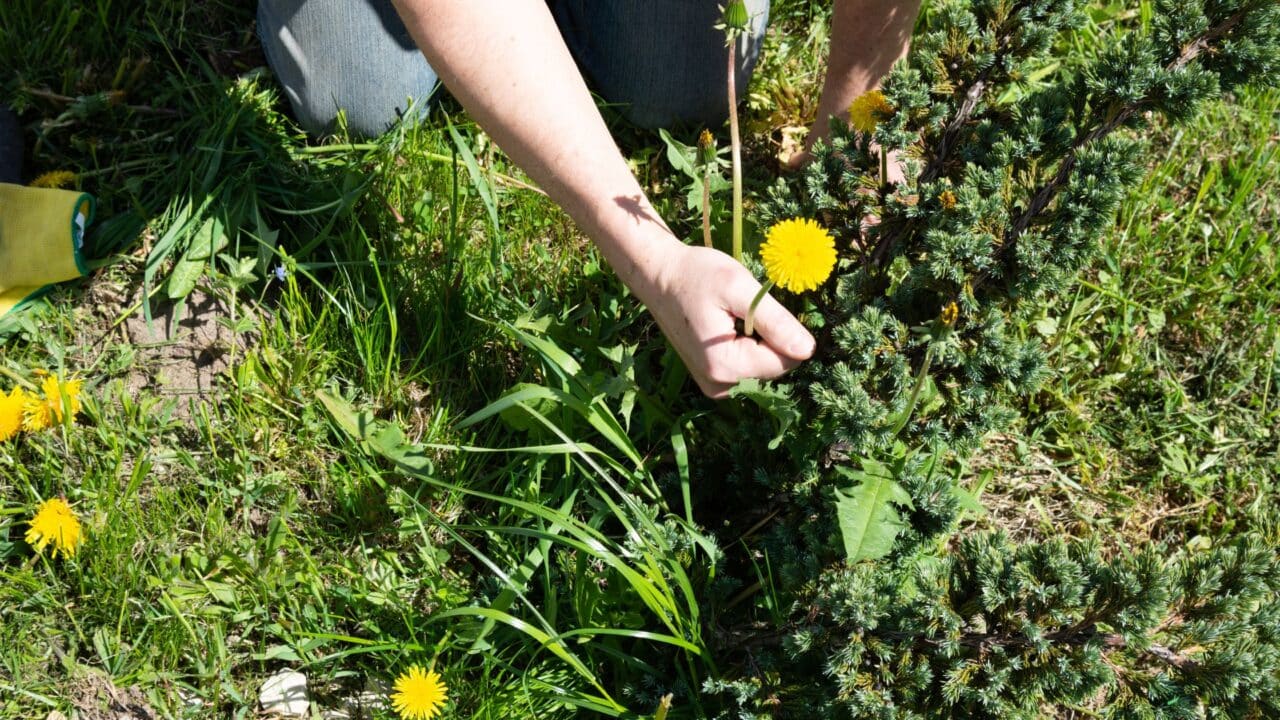Yes — you can overseed a weedy lawn without killing the weeds first, especially in late summer or early fall when weed pressure naturally declines. But for best results, thinning or spot-treating the worst weeds beforehand and improving seed-to-soil contact will give your new grass the upper hand.
Introduction: Seeding Into a Messy Lawn
Many Northeast Ohio homeowners delay overseeding because their lawns are overrun with crabgrass, clover, or dandelions. The instinct is: Shouldn’t I kill all the weeds first?
But that’s not always necessary—or even ideal.
If you time your overseeding right and follow a few smart prep steps, you can introduce better grass varieties that slowly take over, making your lawn thicker, healthier, and more weed-resistant over time.
Let’s break down when it’s okay to overseed without weed removal, when to hold off, and what steps to take for the best outcome.
The Case for Overseeding Without Full Weed Removal
There are a few reasons why it’s often better to overseed before attempting to kill all your weeds:
🕑 1. Timing is Everything
The best window for overseeding in Northeast Ohio is mid-August to late September. If you wait too long for a full weed kill, you’ll miss that sweet spot for seed germination.
🧪 2. Most Herbicides Interfere With Seed Growth
Pre-emergent weed killers (like crabgrass preventers) and many broadleaf herbicides linger in the soil for weeks and can prevent new grass seed from sprouting.
If you use something like 2,4-D (common in weed & feed blends), you usually need to wait 3–4 weeks before seeding.
🌿 3. Weeds Often Die Back on Their Own
Many common lawn weeds—especially annuals like crabgrass and spotted spurge—die off naturally in the fall. That makes early fall the perfect time to seed over them, letting your new grass take root while weeds fade away.
Smart Overseeding Strategy for Weedy Lawns
If you’re not going to fully remove weeds first, here’s how to give your grass the best shot at success:
Mow Low Before Seeding
-
Drop your mower to 2 inches or lower to reduce weed canopy.
-
This lets sunlight reach the soil surface and gives new seed a fighting chance.
Core Aerate or Dethatch
-
Break up compacted soil and create space for seed-to-soil contact.
-
Aeration is a must if your lawn is dense or the soil is clay-heavy (very common in Northeast Ohio).
Spot-Treat the Worst Weeds
-
Use a targeted herbicide or hand-pull aggressive patches (like creeping charlie or thistle).
-
Do this 2–3 weeks before seeding, so the herbicide has time to break down.
Use a Dense Seed Blend
-
Choose a high-quality mix of ryegrass, tall fescue, and fine fescue.
-
These germinate quickly and establish fast, helping outcompete lingering weeds.
Water Consistently
-
Keep the seedbed moist for 2–3 weeks straight.
-
Even partial drying can lead to patchy growth—especially with competition from weeds.
What to Expect After Overseeding a Weedy Lawn
Overseeding doesn’t create instant perfection—but it starts changing the balance of your yard.
Here’s what typically happens:
-
Week 2–3: New grass begins sprouting, especially in bare or thinned areas.
-
Week 4–6: Lawn looks fuller, weeds begin to thin or die off from crowding.
-
Fall into Spring: Weeds diminish naturally over winter; new grass resumes growth in early spring.
-
Next Season: The lawn is noticeably thicker. You can do a second round of overseeding for even better results.
When You Should Kill Weeds First
There are a few cases where you should delay overseeding and focus on weed removal first:
-
Heavy Creeping Weeds: Ground ivy, nutsedge, and bindweed will smother seedlings.
-
Thick Mat of Crabgrass: If crabgrass has taken over completely, it’ll die in fall, but the thatch can block seed.
-
Persistent Broadleaf Infestations: If more than 50% of your lawn is dandelions, plantain, or clover, it’s worth tackling them early and planning to overseed a few weeks later.
Common Mistakes to Avoid
Applying Weed & Feed Right Before Overseeding
These products contain pre-emergent herbicides that inhibit seed growth. Always check the label and time accordingly.
Skipping Aeration
Overseeding without loosening the soil first dramatically reduces germination rates.
Watering Inconsistently
Your seed is competing with weeds for moisture. Missing a day or two can stunt progress.
Using Cheap Seed
Low-quality blends often contain weed seed or filler. Look for certified seed with high germination rates.
Pro Tip: Take a Long-Term View
Overseeding a weedy lawn is rarely a one-time fix. But it’s a smart first step in rebalancing your lawn’s ecosystem.
-
Each fall overseeding round boosts grass density
-
Thicker grass chokes out future weed germination
-
Better varieties mean less fertilizing and watering down the road
By staying consistent with mowing, watering, and yearly overseeding, you’ll naturally reduce your weed load without needing to go scorched-earth with chemicals.
FAQ: Overseeding and Weeds
Can I overseed and apply weed killer at the same time?
No. Most herbicides interfere with seed germination. Always check the label and wait at least 3 weeks after application before overseeding.
Will new grass outcompete the weeds?
Over time, yes—if you seed thick enough, water consistently, and mow properly. Thick, healthy turf is nature’s best weed control.
Should I pull all the weeds before overseeding?
Only the worst offenders. Focus on reducing the canopy and improving soil contact rather than total weed removal.
Can I overseed in spring if my lawn is too weedy now?
You can, but fall is usually better. Spring has higher weed pressure and shorter establishment time before summer stress kicks in.
Will one round of overseeding fix everything?
Probably not. Most weedy lawns need at least 2 years of consistent overseeding and smart maintenance to fully transition.

